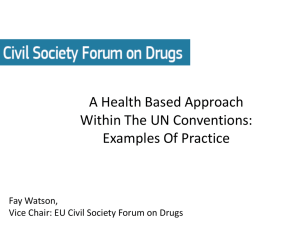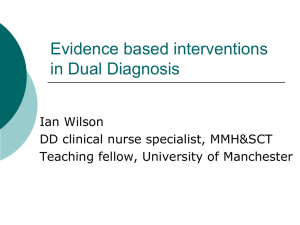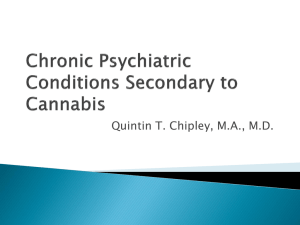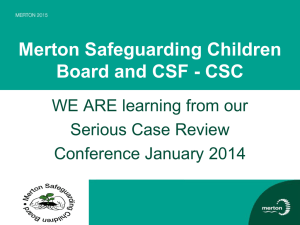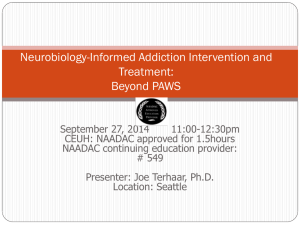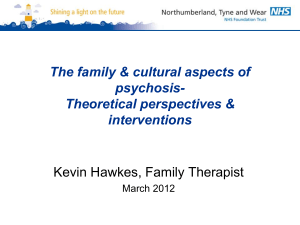Dual Diagnosis Dr M Rowlands 23rd March 2012
advertisement
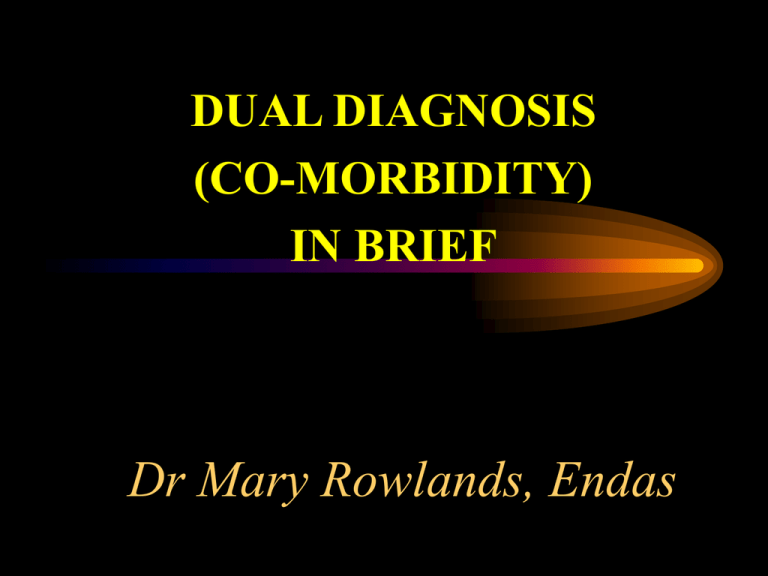
DUAL DIAGNOSIS
(CO-MORBIDITY)
IN BRIEF
Dr Mary Rowlands, Endas
Important reference
• Co-existing Problems of Mental Health and
Substance Misuse
• Dual Diagnosis
• A Review of Relevant Literature
• College Research Unit
• Vanessa Crawford
• Editor Professor Ilana Crome, 2001
Aims of today’s course:
• To raise awareness of the nature and
prevalence of Dual Diagnosis.
• To enable participants to understand
why dual diagnosis is complex.
• To examine brief detection &
screening for this client group.
Aims of today’s course:
• Improve knowledge of increased
vulnerability in mentally ill to use
substances & sub-optimise MH Rx
• To challenge attitudes towards
this client group &
Mental Health & Addiction Service
response in context that Substance
Use is common in UK
Objectives for today’s course:
• To develop your skills in the brief assessment
of individuals with a co-morbidity.
• To be able to determine differences and
overlap between symptoms of mental health
problems and substance misuse.
• For you to feel more confident in being able
to manage individuals with complex needs.
• If time Department of Health funded Systematic Review of
evidence that cannabis use increases risk of psychotic and
affective disorders (June 2005-June 2006)
Definitions of Dual Diagnosis
• “The term dual diagnosis covers a broad
spectrum of mental health and substance
misuse problems that an individual might
experience concurrently. The nature of
the relationship between these two
conditions is complex………Services
need to be clear at the outset which
individuals they intend to provide
interventions for”
(Department of Health Mental Health Policy Implementation Guide May 2002)
Definitions continued:
• Co-morbidity (Dual Diagnosis) is the cooccurrence of severe mental health
problems (and personality disorder)
which are caused or complicated by
problematic consumption of illicit
substances, misuse of prescribed drugs or
alcohol.
(Nottingham Dual Diagnosis Team)
Definitions continued:
“The term Dual Diagnosis is not helpful in describing this
group. First the term is non-specific and could refer to a
whole range of problems.
Secondly low levels of substance misuse
(i.e.
not enough to merit a diagnosis of
dependence or abuse)
can have a significant effect on those individuals with severe
mental health problems and therefore does not warrant the
label diagnosis.”
(Graham H et al 2003)
Severe Mental Illness:
The DoH sets out 5 defining characteristics:
• They are diagnosed (typically with
Schizophrenia or Bipolar affective disorder).
• Are substantially disabled due to their illness.
• They are currently displaying florid symptoms
as part of an enduring condition.
• Have suffered recurring crises resulting in
admissions or interventions.
• They may at times pose a significant risk to
themselves or others.
DoH definition examples:
Severity of
substance misuse
E.g. A man who drinks
2.5 litres of cider per
day and experiences
increasing anxiety
HIGH
LOW
Severity of mental
health problem
E.g. a young woman who takes
ecstacy at the weekend and who
is now experiencing depression
throughout the week
LOW
E.g. A 22 year old man who
has a diagnosis of bi-polar
disorder who binge drinks and
has started experimenting
with intravenous drug taking.
HIGH
E.g. A woman with
schizophrenia who smokes 23 joints daily to compensate
for social isolation
Service Models of joint mental
health and addiction services
• Consecutive-dangers slip between services
• Addiction services deal with mild/moderate
mental illness mainly affective disorder
• Parallel-dangers of sub-optimal treatment
• Dedicated DD-not cost-effective deskills
• Integrated-DOH recommendation
• Low priority with gate-keeping for both services
Prevalence in the UK
• An inner London Study showed that 36% of people
with a psychosis had abused substances. (Tyrer et al 1999).
• A recent study conducted in 2 London Boroughs,
Nottingham and Sheffield showed that prevalence of
drug taking in people with mental health problems
had risen to 44%. (Weaver et al 2003)
Client Profile:
•
•
•
•
Male (80%)
Between the age of 23 & 35.
Poly-drug user. (55%)
Engaged in experimental & opportunistic
drug taking.
• High levels of risk
• (40% inject,
violence or suicide)
In homeless population
•
•
•
•
Higher rates of Substance Misuse
Higher rates of SEMI
Higher rates of DD
Increased risk of sharing injecting
equipment
• Increased risk of unsafe sexual practices as
in all DD
The drugs that they take:
• 49% take stimulants
(amphetamines and cocaine).
• Crack smoking is sharply on
the increase.
• 27% take heroin.
• 37% smoke cannabis and drink
heavily.
• 40%+ inject the drugs they take
often straight away and in high
risk sites.
Vulnerability to Alcohol Misuse
• Most commonly available and often
cheapest drug
• More vulnerability in:
– Bipolar and affective disorders
– non-compliant, socially isolated
Increased dose recruits additional
monoamines
• Dose
Low
Cannabinoids neurobiology
• CB1 receptors widely
distributed in cortex
• Endogenous cannabinoids
(eg anandamide)
• Δ9 THC releases dopamine
from nucleus accumbens
and prefrontal cortex
• Inhibits GABA & glutamate
transmission
Brainstorm.
Why might people with
severe mental health
problems take drugs or
alcohol ?
Psychosis is lonely in adolescent development
• Substance misuse aetiology as
for general populationfun,escape, relaxation,
environmental access
• providing an accepting social
in group initially and delays
effective early intervention
• Neurodevelopment in brain
regions associated with
learning for adult roles:
motivation,impulsivity also
confer addiction learning
(Chambers RA, AM J Psych
2003; 160:1041-1052)
?Already primed dopamine
reward circuits
• E.g.70% cf 25% smoke before first
symptoms of mental illness
• ?common aspects to both conditions of
dopamine circuits dysfunction.
• Volkov ND. Cereb Cortex 2000;10:318-325
Pills DD want
• Development of severe mental
illness and substance misuse at key
stage of teenage autonomy leads
to conflict
• Increases hostility
• Familial high expressed emotion
worsens
• Further alienates support network
• Increases vulnerability to
homelessness and coming within
the CJ system
versus pills DD don’t want
Non-compliance
• &to
• addiction treatment
Dual Diagnosis worsens
SMI outcomes
–Increases relapse rates
–Rehospitalisation
–Increases positive symptoms
of psychosis
–Worsens clinical and
functional outcomes
Interactive work.
What are the
differences between
symptoms of severe
mental health
problems and
symptoms
relating
to drug taking?
Clue ICD
Psychosis during cannabis intoxication
• Surveys of cannabis users
– 15 % report experiencing brief psychotic symptoms
(paranoid beliefs / hearing voices)
• Experimental studies of intravenous THC (DeSouza 2004)
– 22 subjects, randomly given IV THC or placebo
– Highly significant increases in psychotic symptom
scores
– Completely resolved within 3 hours, and no effect up to
6 months
Cannabis and psychosis
cannabis
use
delusions, hallucinations &
thought disorder during
cannabis intoxication
acute & transient
psychotic disorder
schizophrenia
time
other ‘chronic’
psychoses
psychotic
symptoms
not due to
direct
biological
effects of
exogenous
cannabinoids
Cannabis and psychosis persisting beyond
intoxication effects
•
“Cannabis-induced
psychosis”: Numerous case reports
• Typically described as onset of psychotic illness
following cannabis use, and resolving usually within 1-2
weeks
• Observe acute & transient psychotic illness
• Assumptive role of cannabis in aetiology….but 10% of
young adult population use cannabis regularly
Brief Assessment of
Clients With Substance
Misuse Problems.
Three main areas of assessment:
• Detection and Screening.
• In depth assessment.
• Risk assessment.
Dual diagnosis MHPIG states:
• “Since substance misuse among those with mental
health problems is usual rather than exceptional and
results in poorer treatment outcomes, it is necessary
to consider its presence in all assessments undertaken
by mental health services”
• But St Georges School of medicine in London
recently found that: 26% of clients who reported
substance misuse in their survey had not been
assessed by acute in-patient staff as having a drug or
alcohol problem.
What have I got to lose except my
• Values
• Experience
• Taboos
• Fears
• Prejudices
• For a Motivational
approach
Detection and Screening.
• SuMMBAT (Substance Misuse & Mental
health Brief Assessment Tool).
• Self report.
• Laboratory tests (including urine, hair &
blood screening).
• Other forms of screening (Micro-lines & saliva
swabs).
• Records and other collected data.
Why Screen?
• It gives an accurate snap shot of drugs taken.
• Can help establish if the pattern of drug taking is
linked to changes in MH.
• A collection of samples over time give a clear
indication of their pattern of drug taking.
• Regular screening can act as a point to reinforce
their motivation.
• Clients may not be aware or clear of what they
have taken.
• If used in a non punitive way it can become an
objective and therapeutic intervention.
• It helps us study mood, behaviours and
symptoms and reflect these to the client.
SuMMBAT:
SuMMBAT guidelines:
Which substances do they take?
• Does the client know?
• Consider other substances e.g. Px, volatile
substances & mushrooms
How much do they spend?
• A general indication of level of consumption.
Do they inject/smoke etc?
• Which area of the body do they inject into?
• Where do they get their works?
• Do they inject with anything in particular? (e.g.
lemon juice)
SuMMBAT guidelines:
How often?
• Indicates the main pattern of drug taking e.g
regular or binge.
How long for?
• Indicates the impact that drug use may have
had on M.H.Ps & lifestyle.
• Level of tolerance
SuMMBAT guidelines cont’d:
What is their MH diagnosis?
• Highlights why a client may be using a
given substance.
• Is it directly related to their drug of
choice?
What are the positive effects?
• Self-medication for illness or Px
medication.
• Social inclusion.
• Coping mechanisms.
• Lifestyle.
What are the negative effects?
•Physical & mental health
•Finances
•Social effect
•Accommodation
•Work or activity
•Offending.
Degree of motivation:
•Asking the client what they want to achieve.
Control or Abstinence?
•Even if motivation is low then some interventions are
still indicated.
SuMMBAT Guidelines Cont’d:
What help does the person want?
• Education/information.
• Harm-minimisation.
• Detox.
• Abstinence.
• Relapse prevention.
Any previous treatment?
• Useful to ascertain if they have engaged well,
previous detoxes that worked/failed, notable
withdrawal experiences and periods of
control/abstinence.
Assessment:
• “Accurate assessment is fundamental to the
effective management of people with a dual
diagnosis.
• The aim of an assessment is to give the
practitioner a clear picture of what is going on for
that person and what is contributing to their
distress”
(RCP Research Unit, 2002. Co-existing problems
of mental disorder and substance misuse
(dual diagnosis) an information manual.)
Specialist Assessment.
• “Specialist assessments are undertaken to
determine the nature and severity of substance
misuse and mental health problems, and to
identify corresponding need.
• The more comprehensive and focussed the
assessment
• the better the understanding will be of the
relationship between the two disorders.”
Risk Assessment:
• “Routine
risk assessment protocols need to
address specific factors for individuals
with a dual diagnosis.
• The severity of substance misuse,
including the combination of substances
used, is related to the risk of overdose and
suicide.
• Exploration of the possible association
between substance misuse and increased
risk of aggressive or anti-social behaviour
• forms an integral part of the risk
assessment, and should be explicitly
documented if present.” (DoH Dual Diagnosis MHPIG, 2002).
Risk Assessment cont’d:
Other aspects to consider include:
• Risk to the client and others due to drug
taking paraphernalia. E.g. the potential for
needle stick injuries as a result of
improperly discarded needles and syringes.
• Risk due to blood borne infections. E.g.
Hepatitis and HIV.
• Risk due to overdose i.e. accidental
overdose of illicit substances.
Risk Assessment cont’d:
• Risk of abuse by others. E.g. clients can be
dis-empowered or abused by drug pushers
who prey on them for money or drug users
needing a place to “SCORE”.
• Risk due to violence. Research has shown
that this client group is more likely to be
unpredictable, aggressive and violent. There
is a potential risk to staff due to some of the
individuals that a client with a co-morbidity
may mix with.
• Risk of relapse as a direct result of their
drug or alcohol problem
Harm reduction –CHALLENGES
traditional values
Reducing blood
borne viral
transmission
Reducing
quantities of
alcohol
drunk/drugs
used
Recovery Approach in Co-morbidity
• Goal Hierarchy towards
Opportunity
abstinence
Control
• Personal values &
Hope
• meaning for life goals
• Risk management joint
approach with clients and
psychiatric & substance misuse
services
Other questions you might ask…
• What do they know/understand about the
substance and it’s effects?
• What effects do they get from their
psychiatric medication?
• What are their social circumstances?
• What have they done in the past to help
control or abstain from drug of choice?
Case Study:
• Adam is a 34 year old man who has a diagnosis of
paranoid schizophrenia. Until recently he lived at
home with his mum and step father. He now lives in a
flat in Newtown after being thrown out “For getting
lairy” his mum tells you.
• Adam injects around 1 gramme of amphetamines 4
days per week. He also takes heroin which he injects
intramuscularly, cocaine which he also injects and
occasionally smokes crack. In the past he has drunk
heavily and also taken steroids.
• Discuss how you would assess Adam’s needs, what
issues you might prioritise and what you would do to
try to ensure he receives a comprehensive service.
Stages of treatment:
• Assessment.
• Engagement:
Building a therapeutic relationship.
Doesn’t necessarily tackle drug and alcohol
issues immediately.
• Early empowerment:
Gives the client relevant verbal and written
information that they may not have had before.
Stages of treatment contd:
• Late empowerment.
Helps the client to self monitor using drug/drink
diaries.
Simple monitoring.
Goal setting.
• Action/Active phase.
Active detoxification/control of substance taking
(based on goals set).
Controlled drinking groups.
• Relapse prevention including a relapse prevention
plan.
Engagement and risks
•
•
•
•
UK Mental Health Services
AOT
Early Intervention Services
Substance Misuse can
present in crisis but would
normally be excluded from
Crisis Team assessment
• Dual diagnosis integrated
model with MH Services
lead for severe & enduring
MI due to limited evidence
for dedicated service
• Psychosocial interventions
are the evidenced treatments
to improve outcomes not
substitute medication for
stimulant/cannabis abuse
• No evidence of improved
outcome by matching
MET=CBT=social Network
Therapy=12 step for alcohol
(1997 Project Match)
• Community reinforcement
programmes- eclectic,
intensive,repeatedly available
to engage, aftercare
is evidenced
?
1936 Mythology
2006 Limited
Evidence
1936…
“One moment of
bliss, a lifetime of
regret ....”
2004….
“We and about five other studies have shown that if you start
taking cannabis early and heavily you are about seven times
more likely to develop schizophrenia”
BBC news 22nd Jan 2004
“Prohibitionists love to claim cannabis causes schizophrenia.
Mostly because all their other claims have been proved wrong.
Just like this one will soon be.”
The Hempire Aug 2004
ACMD
• Advisory Council on the Misuse of Drugs
– Independent expert body
– Remit to review drug situation and advise Government on
prevention / dealing with social problems
• Decision to downgrade based on ACMD report March 2002
• Request by Home Secretary in March 2005 to review evidence
• Department of Health funded Systematic Review of evidence
that cannabis use increases risk of psychotic and affective
disorders (June 2005-June 2006)
Cannabis and schizophrenia
• Cross-sectional studies show that cannabis use in people with
schizophrenia is more common than in general population
• Limitation of cross-sectional studies
– Cannabis increases risk of schizophrenia?
– Schizophrenia increases likelihood of using cannabis?
(self-medication or reverse causation effect)
Longitudinal or cohort studies
cannabis
time
cohort
no cannabis
Systematic review of cannabis use and risk of
developing psychoses
• What is the evidence that cannabis use increases risk of
developing schizophrenia?
• What is the evidence that cannabis use increases risk of
developing other psychoses?
• What is the evidence that cannabis use in people with
schizophrenia results in a poorer long-term outcome?
Systematic review of cannabis use and risk of
developing psychoses
•
•
•
•
Longitudinal (cohort) studies
Reverse causation excluded?
Intoxication effects excluded?
Confounding assessed?
cannabis use
schizophrenia
personality traits
Systematic review of cannabis use and risk of
developing schizophrenia and other psychoses
• Department of Health funded
•
•
•
•
•
Glyn Lewis
Tess Moore
Anne Lingford-Hughes
Peter Jones
Tom Barnes
Search strategy: databases
• Medline, EMBASE, CINAHL, PsycINFO, ISI Web of Knowledge,
ZETOC, BIOSIS, LILACS, MEDCARIB, National Research
Register
• Contacting experts: Louise Arsenault IOP, Bovasso, Michael
Davidson, Mark Weiser NY/Israel, Louise Degenhardt, William
Eaton NY, Robert Ferdinand, David Fergusson (Christchurch),
John MacLeod, Robin Murray, George Patton Melbourne,
Richie Poulton Dunedin, David Semple, Jim van Os Maastrict,
Helene Verdoux Bordeaux
Review flow chart
Total hits 6718
(Duplicates 2684)
Reference lists expert
knowledge and other
databases = 47
Total N=4037
Titles and abstracts possibly
relevant N = 169
Papers not relevant
(full papers or
abstract)
n=139
Papers included
Psychosis
n=9 (6 studies)
Papers included
Depression
n=19
Titles and abstracts
which were very
unlikely to be relevant,
excluded:
n= 3868
Summary of studies included
N in
cohort
Length of
follow-up
N with
psychotic
outcome
Psychosis type
Effect of
cannabis on
risk
Swedish conscripts
(Andreasson 1987)
(Zammit 2002)
50,087
27 years
362 (0.7%)
schizophrenia
Dunedin
(Aresenault 2002)
759
11 years
a) 190 (25%)
b) 25 (3.3%)
a) psychotic symptom
b) schizophreniform
NEMESIS
(van Os 2002)
4045
3 years
a) 38 (1%)
b) 10 (0.25%)
a) mild symptom
b) moderate symptom
EDSP
(Henquet 2005)
2437
4 years
a) 424 (17%)
b) 174 (7%)
a) psychotic symptom
b) 2 symptoms
Christchurch
(Fergusson 2005)
1055
2-7 years
N/A
psychotic symptom
ECA (Tien 1990)
4994
1 year
507 (11%)
psychotic symptom
Ever use of cannabis: adjusted results - all psychoses
odds ratio
(95% CI)
Study
% Weight
ECA (any Sx)
1.30 ( 0.98, 1.73)
16.1
Christchurch (any Sx)
1.28 ( 1.04, 1.57)
17.6
Munich (any Sx)
1.53 ( 1.13, 2.07)
15.8
Munich (2+ Sx)
2.23 ( 1.52, 3.28)
14.1
Nemesis (any mild Sx)
2.76 ( 1.18, 6.46)
6.8
Nemesis (any mod Sx)
24.17 ( 5.44, 107.42)
2.9
Nemesis ('disorder')
12.01 ( 2.24, 64.36)
2.3
Dunedin 15 (schizophreniform)
3.12 ( 0.73, 13.31)
3.0
Dunedin 18 (schizophreniform)
1.42 ( 0.54, 3.74)
5.7
Swedish (schizophrenia)
1.50 ( 1.11, 2.02)
15.8
1.83 ( 1.39, 2.40)
100.0
Overall
.009014
1
odds ratio
reduced risk
increased risk
110.938
Odds ratio: The ratio of the probability of having a disease in a population
exposed to a certain risk factor (e.g. cannabis use) and the probability of
having the same disease in a population not exposed.
Ever use of cannabis: adjusted results - psychotic disorders
odds ratio
Study
(95% CI)
% Weight
Nemesis ('disorder')
12.01 ( 2.24, 64.36)
13.2
Dunedin 15 (schizophreniform)
3.12 ( 0.73, 13.31)
16.2
Dunedin 18 (schizophreniform)
1.42 ( 0.54, 3.74)
25.7
Swedish (schizophrenia)
1.50 ( 1.11, 2.02)
44.8
2.19 ( 1.07, 4.48)
100.0
Overall
.009014
1
odds ratio
reduced risk
increased risk
110.938
% weight: statistically adjusted to take account of actual
or potential confounding factors.
Most freq uent use: adjusted results - all psychoses
odds ratio
Study
(95% CI)
% Weight
Swedish (>50 times)
3.10 ( 1.72, 5.58)
18.6
NEMESIS (>weekly)
6.81 ( 1.79, 25.91)
5.9
EDSP (daily)
2.23 ( 1.30, 3.83)
20.1
ECA (daily)
2.40 ( 1.55, 3.72)
24.0
Christchurch (daily)
1.56 ( 1.20, 2.03)
31.3
2.31 ( 1.62, 3.29)
100.0
Overall
.009014
1
odds ratio
reduced risk
increased risk
110.938
What factors might have lead to studies overestimating the true association between cannabis use
and psychosis?
Reverse causation
well
psychosis
cannabis
use
sub-clinical
symptoms
prodrome
Confounding
well
psychosis
cannabis
use
personality traits,
other drugs…
Bias: intoxication effects
well
psychosis
cannabis
use
continued cannabis
use leads to
intoxication symptoms
(regular users)
Quality assessment of studies included
Reverse causation
excluded
Intoxication effects
excluded
Number of
confounders (%
change from crude)
Swedish conscripts
(Andreasson 1987)
(Zammit 2002)
++
++
11 (30% )
Dunedin
(Aresenault 2002)
-
+
4 (no crude results)
NEMESIS
(van Os 2002)
++
+
6 (35% )
EDSP
(Henquet 2005)
-
+
9 (15% )
Christchurch
(Fergusson 2005)
+
-
17 (30% )
ECA
(Tien 1990)
++
+
5 (15% )
What factors might have lead to studies underestimating the true association between cannabis use
and psychosis?
Bias: attrition
well
psychosis
cannabis
use
attrition greater in
cannabis users who
become ill?
Bias: random misclassification
well
psychosis
cannabis
use
cannabis dose
measured
inaccurately
change in cannabis
use over time
Sensitive periods of risk?
• Cerebral development incomplete until late teens
(myelination, synaptogensis..)
• Any evidence for greater risk if use cannabis during early
adolescence compared to adulthood?
Age at first use of cannabis
• Dunedin
– Age 15
– Age 18
(symptoms)
*= 6.6 (4.8, 8.3)
(symptoms) risk difference = 1.0 (0.3, 1.8)
– Age 15 (schizophreniform) OR = 3.1 (0.7, 13.3)
– Age 18 (schizophreniform) OR = 1.4 (0.5, 3.7)
Risk Difference is the risk in the treated group minus the risk in the control group ...
• Swedish conscripts
– Age 15 (schizophrenia) OR = 1.2 (1.0, 1.4)
– Age 18 (schizophrenia) OR = 1.2 (1.1, 1.4)
*Multiple logistic regression analyses showed cannabis use by 15
years &18 years had more schizophrenia symptoms than controls
at age 26yrs
Cannabis by 15 yrs more than 4 times as likely to have
schizophreniform disorder at 26 years than controls.
Age at first use of cannabis
Risk Difference :
risk in the treated group minus the risk in the control group
(confidence intervals).If an experimental intervention has an
identical effect to the control, the risk difference will be 0.
If it reduces risk, the risk difference will be less than 0; if
it increases risk, the risk difference will be bigger than 0.
Risk Difference is the risk in the treated group minus the risk in the control group ...
Summary of findings relevant to clinical practice
• Only one longitudinal study that examines effect of cannabis use
on risk of schizophrenia
• Two studies examine other ‘similar’ outcomes:
– Dunedin cohort: 3.5% schizophreniform disorder in 1 year
(200x more than expected 0.015% schizophrenia)
– NEMESIS: ‘needs-based diagnosis’ = most severe symptoms
(0.2% in 3 years)
Summary of findings relevant to clinical practice
• Reverse causation unlikely given study designs
• Confounding
– Associations all reduced by 15-40% after adjustment
– Associations persisted after adjustment
– Residual confounding possible
• Intoxication
– Unlikely given assessment tools
– However, how do you exclude this in regular users?
Support for causality
• Consistency of results
– Increased risk of psychoses in all these studies
– Not adequately explained by bias, confounding or reverse
causation
• Dose-response effect in all studies that examined this
• Compatible with other sources of knowledge
– Cannabis intoxication psychosis
– Neurobiology of cannabinoids & abnormalities in schizophrenia
• …There is always room for doubt….
Unanswered questions
• What effect does regular use of cannabis over many years
have?
• What about exposure during early teenage years?
• What about use of higher potency forms of cannabis?
• What about risk in those already vulnerable, eg: family history?
• Any other groups where cannabis use may be particularly
harmful?
– eg: Catechol-O-Methyl Transferase genotype regulates
dopamine metabolism (Caspi et al 2004)
• What about time trends?
Are future studies likely to help?
• Schizophrenia incidence approximately 15/100,000/year
• Cohort study of 10,000 people, followed up for 20 years age 12-32
– Probably about 30 people with schizophrenia…
• More reasonable to study ‘endophenotypes’ of schizophrenia
– eg: specific neuropsychological deficits
• Animal models of endophenotypes may be particular helpful
• Definitive answer not likely in decades to come
What if someone already has schizophrenia?
• Part of current systematic review; not complete as yet
• Clinical experience and evidence from a number of studies suggest
that cannabis use:
–
–
–
–
Increases relapse rates
Increases positive symptoms of psychosis
Is associated with reduced compliance with medication
Worsens clinical and functional outcomes
• Strength of evidence regarding this unclear
• Future studies feasible, as well as intervention trials for reducing
cannabis use in people with schizophrenia
Public health perspective
Does cannabis cause psychotic illnesses?
or..
‘Would reducing cannabis use reduce the incidence of psychotic
illnesses?’
• Assuming the strength of association from studies above are
correctly estimated and that cannabis use is truly causal...
• Approximately 10-20% of psychosis outcomes in these studies
would not have occurred if no-one used cannabis
Individual perspective
• Individual lifetime risk of schizophrenia is 0.7%
• If using cannabis daily increases risk by 2.5 times:
– Lifetime risk of schizophrenia = 0.7% x 2.5 ≈ 2%
• Individual risk relatively low, but may be much higher if heavy or
frequent use, if use more potent forms, or use at an early age
• Furthermore, it may be the only modifiable risk factor there is at
present
Clinical perspective
• If someone has experienced any psychotic-like phenomena
following use of cannabis should be strongly advised about
possible risk of developing a severe psychotic illness
• If a patient has a psychotic illness, they should be routinely
strongly advised (including written information) that using
cannabis may make this worse
• We should actively target family members of patients with
schizophrenia to advise about possible risk if use cannabis
Clinical perspective
• Message to public
The evidence supports the view that using cannabis can
increase risk of developing a psychotic illness, including
chronic and severe psychotic illnesses such as
schizophrenia
• Reference
• ACMD Further consideration of the classificatioof cannabis
under the Misuse of Drugs Act 1971, HMSO,2006
